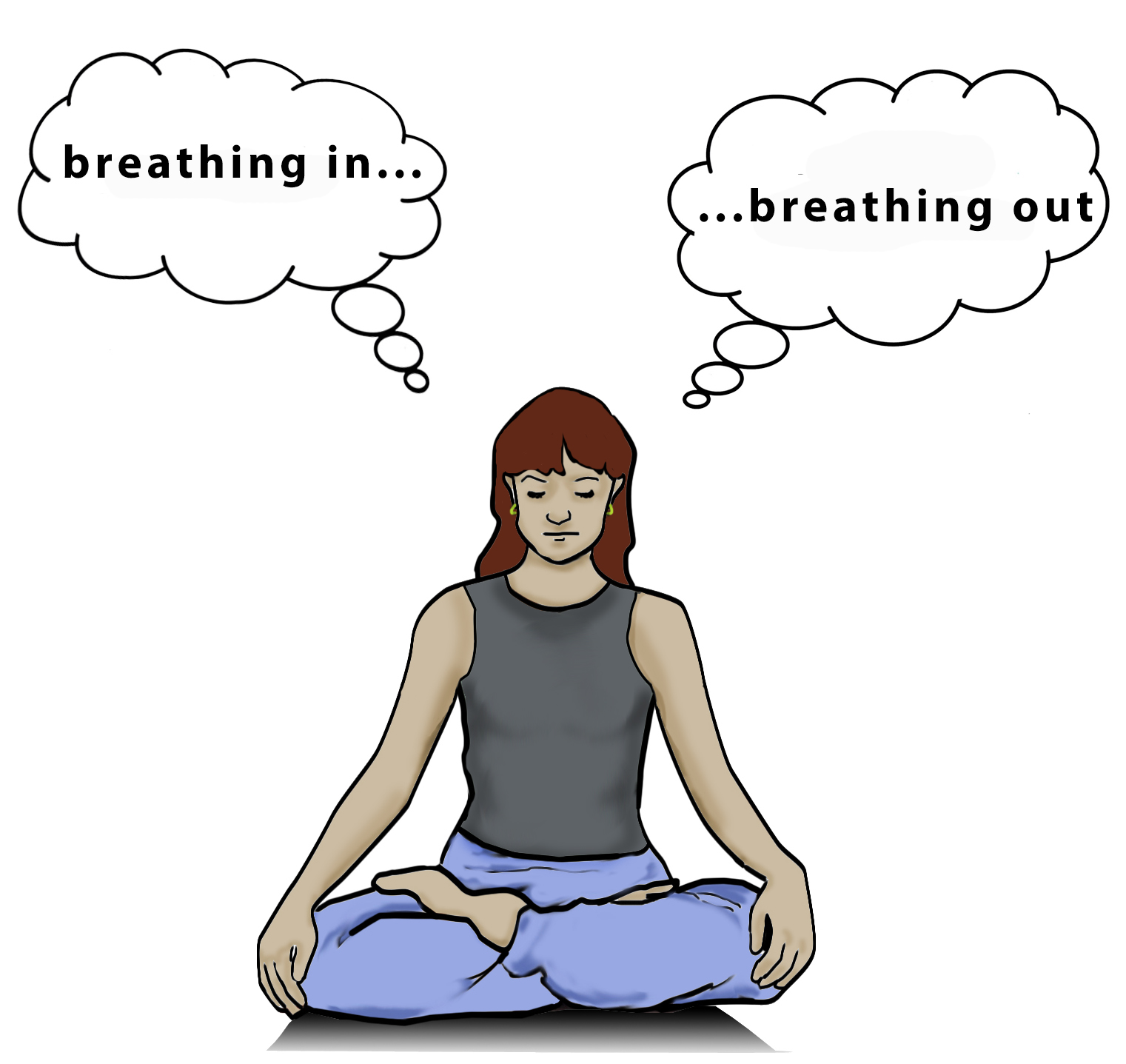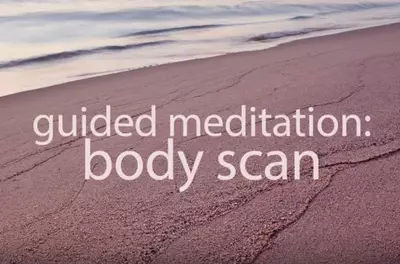
If you don’t have prior experience with mindfulness meditation, please see the “Cautions” section below and talk to your healthcare provider if you have questions about whether a meditation practice is appropriate for you at this time in your life.

Why is it important to practice mindfulness?
Imagine you are learning to play the acoustic guitar. The first time you sit down to practice, would you expect to be able to effortlessly play your favorite song? Of course not! Learning to play your favorite song on the guitar would take lots of practice. Mindfulness, like music, requires regular practice so you can develop greater levels of skill.
The more you formally practice mindfulness, the more you will begin to experience moments of presence throughout your day. Your “being” becomes accessible to you so that even in the midst of a whirlwind of activity, you can still act from a place of greater presence and resilience.
10-min guided meditation
Practice sitting meditation with guided instructions from a Bakken Center mindfulness teacher.
Click the button below, then click the Play button on the audio screen. (If you pause the meditation, an ad that says "Explore more music & audio" will appear. To return to the audio, simply click the X in the upper right-hand corner.)
How do I start?
One way to develop mindfulness is the classic sitting meditation where you observe your breath. To try it out:
Choose your posture.
One of the most common postures for practicing mindfulness is sitting. You can sit on a chair or a meditation cushion or bench. There is no magic about any particular seated posture, just ask yourself: what would support my being alert and at ease while I practice mindfulness?
If a seated posture is difficult for your body, then try out another posture, such as lying down or standing. Remember the posture supports the practice, it doesn’t define it.
Begin with intention.
In beginning any formal meditation practice period, it is very helpful to spend a few moments connecting with your intention. Establishing an intention to practice is often associated with cultivating greater wakefulness and kindness in your life and can be a very nourishing and a powerful form of self-care.
Reflect on your intention for a few moments, and as you hold it in awareness, notice if you can tune into any sensations in your body.
Shift attention to the body.
Let go of the reflection on intention and begin to tune into the felt-sense of your body. Rather than thinking about your body, explore becoming more attentive to your body, from the inside out. Allow yourself to notice the aliveness that is happening inside the body.
Take a few moments to offer kind attention to any areas of the body that might need it. You’re not trying to change, fix, or force the body to relax, rather you’re acknowledging the body as it is in this moment. If you notice that you’re bracing against a physical sensation, then take a few moments to notice this relationship (“Oh, I’m bracing against this discomfort / pain … this is difficult …”) and invite the possibility of kindness – in this way, even if there are painful sensations in the body, you can still try softening the way that you’re relating to them.
 Begin to feel the sensations of the breath.
Begin to feel the sensations of the breath.Begin now to feel the sensations of the breath in the body – wherever you feel these sensations most naturally. For many people the soft, breathing belly is the most supportive place to rest the attention. This deep diaphragmatic breathing can help us to slow down and also breathe more deeply since many of us breathe using only a fraction of our lung capacity throughout the day.
If you don’t easily connect with the breath in the belly or feel uncomfortable connecting there, perhaps try tuning the sensations of the breathing body somewhere else, or simply feeling the sensations of your feet in contact with the ground, or gently receive the natural coming and going of sounds in your environment. Allow yourself to simply rest your attention with the aliveness your body and the present moment, just as it is.
Notice when attention wanders.
At times, your attention will be pulled away from your breathing, or the chosen anchor of your attention, to another experience (a thought train, an emotion, or a memory) and you will get lost inside that experience – no longer aware that it is just a passing phenomenon. Fortunately, at some point you will “wake up,” recognizing that you have lost connection with the present moment.
Identify your attitude.
Take a moment to notice your attitude when you first “wake up” – is it self-critical (“I knew it … I’m bad at mindfulness and I’ll never get it")? Is it non-judgmental (“Ha! … I was lost … it’s great to be aware again!”)? This will let you see directly how judging and self-limiting attitudes often lead to more moments of being lost and non-judging or kinder attitudes support the arising of more moments of mindfulness.
Remember that mindfulness is not about achieving a particular kind of experience, rather it’s developing a steady and balanced mind and heart that can be present to whatever situation or experience arises. When your mind and heart are more at ease, balanced, and fully resourced, thoughts are not a problem, emotions are not a problem, memories are not a problem, in fact, any sense experience is not a problem.
Gently return your attention to your body sensations.
Rather than indulging in thoughts and stories, choose, with kindness and non-judgment, to bring your attention back to the sensations, the aliveness of the breathing body.Sometimes it’s best to take a break.
There are times in practice when our mind and heart are not able to remain steady, balanced, and open to experience. During these times of practice, the most helpful and caring thing to do is to take a break from formal mindfulness practice.
You’ll know it’s time to take a break if you notice that you are extremely agitated, your body is very tense, or you feel like a difficult emotion or thought is in the driver’s seat and your attention is along for the ride.
What are other ways to develop mindfulness?
You don't need to do sitting meditation, there are practices for developing mindfulness in any body posture, such as standing, walking or lying-down. Some people find the body scan meditation a useful way to cultivate embodied attention.
Sometimes you might find moving meditation particularly helpful for settling an active mind. Notice the sensations in your body as you walk—in your legs and feet, arms, chest, and head. As you notice the physical sensations of walking, you may find it easier to drop the tendency to worry, plan, or ruminate on something that just happened.
Options for practice

Walking meditation
In addition to practicing mindful walking as you go about your day or take a walk outside, you can also try a more formal walking meditation.
Walking Meditation
This type of walking is best done in a quiet, private place. Find a spot where you can walk forward and back approximately 10 paces in each direction without obstructions.
Here is one way to do this:
- Stand for a minute and take a few mindful breaths.
- Lift your right foot, move it forward, and place it on the ground in front of you. As you do so, gently note the actions of lifting, moving, and placing as a support to connecting your attention to the physical sensations of each of these phases of movement.
- Do the same with the left foot—lifting, moving, placing.
- Move slowly (but not so slowly that you lose your balance), and be attentive to the sensations in the feet and legs. (Note, you don’t look at your legs and feet, rather keep your gaze and head upright as you walk.)
- Feel the sensations instead of thinking about them. If the gentle noting (see above) is distracting or leads to endless thinking, then don’t use it and stay with the felt-sense of the movement.
- When you reach the end of your path, stop, breathe, and slowly turn around.
- Repeat in the opposite direction.
- When you are done, take a few breaths.
Learning to bring mindfulness into different activities helps bring the benefits more fully into daily life, since we don’t stay in only one posture all day.
Other walking practices
There are many mindful walking practices:
- Make a note to pause and pay attention once in a while as you are walking. You can do this anywhere—while walking down the street, at work, at home.
- Ask yourself when you start to walk “What’s one new thing I can notice?
- Tune into the sounds you hear when walking, or the sights. Don’t try to figure them out or evaluate them (“what is that bird? that is noisy!”). Listen and see from an open and receptive space of mind.
- Stop and take at least one mindful breath when you get to your destination.

Try a body scan
Learn to bring more awareness and relaxation to your body with a 14-minute seated body scan.
Useful strategies for taking a break
If you are agitated or there are other reasons it is time to take a break from meditating, try one of these strategies:
- Talk with a good friend or family member
- Take a long walkTry a self-compassion exercise
- Offer yourself a gentle reminder: “This is difficult. Everyone, not only me, experiences difficulty. May I be patient and kind with myself.”
- Spend time outdoors consciously taking in the beauty of the natural world
- Seek appropriate help from an experienced therapist, counselor, or medical health provider.
Are there any cautions?
While mindfulness meditation can be therapeutic, it is not a replacement for therapy. If you are currently struggling with any of the challenges listed below, consult with your healthcare provider to discuss whether mindfulness meditation is appropriate for you at this time.
- Unresolved trauma
- Major mental illness
- Active addiction / substance abuse
- Suicidal ideation
- Recent losses or significant life transitions
If you are unsure if meditation is appropriate for this or other reasons, ask yourself “how am I handling what’s happening for me right now? Do I feel as though I have sufficient inner resources to meet this experience or do I need additional help from my support network to help me meet this situation?” If you are already feeling depleted and beyond your capacity, it’s best to seek appropriate support from others (including healthcare providers, counselors, support groups) and consider taking up a mindfulness practice once you feel you have increased capacity.
Try Mindful Mondays
Free drop-in sessions held on Zoom from noon to 1 p.m. Central.

Tips to keep going

Fitting mindfulness into a busy life
Finding support
The most common difficulty in maintaining a mindfulness practice is keeping the momentum going after you have begun. It can be a great help to find a local group where you can routinely attend practice periods. Groups like the Bakken Center's Mindful Mondays gentle accountability, support, and encouragement.
If you feel uncomfortable about attending a new group alone, ask a friend to join you the first time. To find a group, try searching the internet for “mindfulness” plus your city or town name.